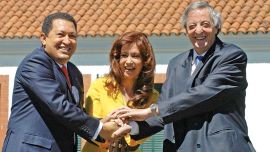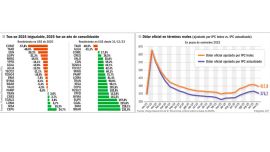After three intense days of action and reaction, the peso rebounded five percent yesterday to close at 22.23 to the dollar, offering the government hope that its attempts to calm the situation and stem the currency’s slump against the greenback had worked.
International observers, however, were far from convinced, with financial media experts using their column inches in outlets to question to warn of slower economic growth and “damaged” credibility.
Yesterday, officials made two interventions to calm the waters. On Friday morning, less than half a day after the peso had slumped nearly eight percent to a record 23.30 against the dollar, the Central Bank said it would hike its benchmark interest rate to 40 percent – its third raise in a week. Meanwhile, Treasury Minister Nicolás Dujovne said the government would also cut its fiscal debt target to 2.7 percent of GDP from 3.2 percent.
He added that a third of the figure would come from improvements in tax collection, while the rest would come from delaying public works projects. “We didn’t want to reduce the number of public works,” he admitted.
Dujovne, with Finance Minister Luis Caputo seated beside him, told reporters the country is on “a path toward fiscal equilibrium.” But he acknowledged that the interest hike could keep the inflation rate from dropping this month. IMPACT ON INFLATION Most experts, however, believe the government’s stated inflation targets are already in major danger of being surpassed. In the first three months of the year, the cost of living rose 6.7 percent, according to thet INDEC national statistics bureau.
Dujovne acknowledged yesterday that high interest rates could impact on growth. “We hope that this hike in the base rate will be as short as possible,” he said.
But the Capital Economics research group said it was likely that interest rates would need to stay at emergency levels “for a prolonged period.”
“In Argentina, we expect rates will need to remain higher for longer to tackle the entrenched inflation problem. And if the Central Bank loosens policy prematurely, it could risk triggering a re-run of the current crisis.”
Argentina’s economy grew 2.8 percent in 2017, and the government is aiming for 3.5 percent this year.
The Central Bank also ratified an inflation target of 15 percent for 2018, although the IMF has projected it will reach 19 percent and private consulting firms see it reaching 20 percent.
“The inflation target is not going to change,” Dujovne said, outlining a longer-term outlook of 10 percent in 2019, and five percent in 2020.
Analysts believe the dollar’s climb against the peso will put pressure on prices, thereby complicating efforts to meet the government’s inflation targets. “Every time, the government is moving away from the inflation target. And putting the rates up is going to put a dent in economic activity which is not going well but will get worse with these concerns which are incorrectly labelled as volatility,” economist Gabriel Rubinstein told TN television.
In the international financial press yesterday, doom-laden warnings ran large. The Economist warned that slower growth was likely on the way, while Forbes op-ed writer Kenneth Rapoza declared that “Argentina is looking like a less attractive place to park capital,” citing a BNP Paribas report that said there was a lack of “central bank credibility.” Rapoza had already gone to town on Wednesday, saying “it might be time to get out of Argentina.” For its part, The Financial Times followed the “turbulence” closely, with the influential newspaper calling the Central Bank’s move to intervene “stunning.”
Friday’s slowing closed off a whirlwind week for financial observers and the government. The Central Bank’s hike of rates to 40 percent yesterday was the third such move in a week. In a statement the institution vowed to use all the tools at its disposal to tamp down inflation.
The bank had already raised its key rate to 33.25 percent on Thursday, but that failed to prevent the peso tumbling 7.64 percent on one of the most tense days yet for President Mauricio Macri’s government. The first hike was last Friday, April 27, when the Central Bank raised the rate to 30.25.
As the dollar closed yesterday, however, the manoeuvres seemed to have stemmed the flow and altered momentum.
Following the decision, the peso – which has lost more than 10 percent of its value in the past month – opened six percent higher against the dollar.
Although it later gave up some of those gains, analysts said the move suggested the authorities had done enough for now to stabilise the peso.
Friday’s interest rate hike, “the third emergency hike in a week, finally seems to have brought some support to the currency,” Capital Economics research group said in a report, suggesting that the bank had “probably done enough for now to stem the tide.” It closed at 22.23 to the dollar.
MOMENTUM
Like other emerging market currencies, the peso has been buffeted by a rise in US government bond yields encouraging investors to buy US Treasury bonds.
Nothing seemed able to stop the dollar’s upward momentum from the closing days of April – neither the three-percent hike in interest rates at the end of the previous week nor the fourday long weekend for May Day.
Amid a global context of depreciation due to rising interest rates in the United States, the paradox was that the country most resisting devaluation is ending up with the most devalued currency among emerging markets.
Ending the previous week just below 21 pesos, the dollar resumed its climb when markets re-opened on Wednesday after May Day despite the sacrifice of a further US$500 million of Central Bank reserves (on top of US$4.3 billion the previous week), closing at 21.52 pesos.
The next day it was the turn of the 23-peso barrier to crumble – rapid progress toward 22.20 pesos served as a signal for the Central Bank to jack up interest rates a further three percent (to 33.25 percent) for the second time in three working days, despite which the dollar shot beyond 23 pesos toward the close of the day (23.30 the official closing figure and 23.50 in some banks) as the run continued. Interest rates for the Central Bank’s Lebac bonds were 38 percent. Cabinet Chief Marcos Peña broke ground. “These situations of volatility should not scare us but should form part of the apprenticeship toward living with a floating exchange rate,” he said, even if the sale of over US$7 billion in the last two months would seem to belie a floating currency.
The alternative was an exchange rate lag affecting jobs and production, Peña added, even if industry now has to absorb the added cost of imported inputs as a result of devaluation. Peña insisted that the Central Bank was in control of the situation but in less than a fortnight its reserves have fallen from over US$60 billion to US$56.14 billion as of Thursday.
Some voices like former economy minister Domingo Cavallo have already begun raising the spectres of the 1989 hyperinflation and the 2001- 2002 meltdown (which started on Cavallo’s watch, of course).
Meanwhile, economic analysts remain focused on that inflation target. The International Monetary Fund (IMF) is projecting 19.2 percent while virtually every other forecast is above 20 percent with some going as high as 24 percent. Argentina’s traumatic national history of hyperinflation, financial crises and bank prompts many locals to buy dollars to protect their savings when financial troubles arise, further complicating the Central Bank’s efforts to prop up the peso.


























Comments